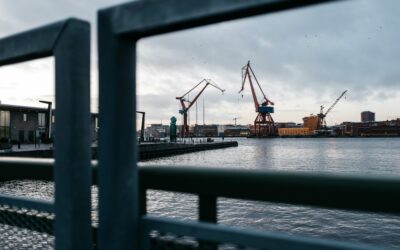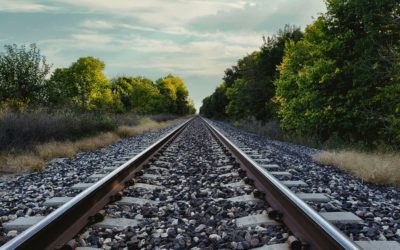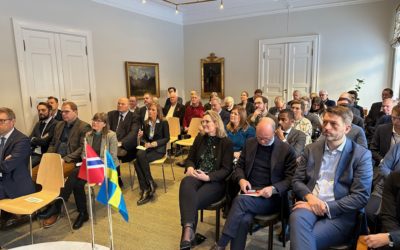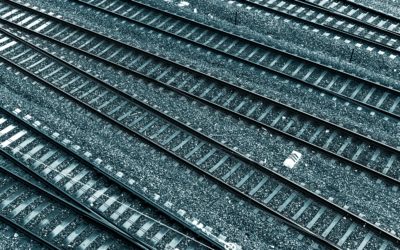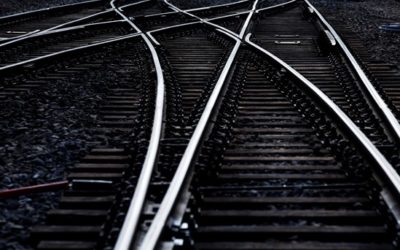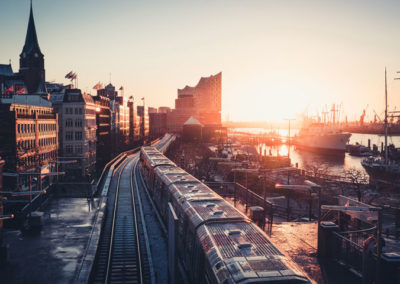DEVELOPING DOUBLE TRACK RAILWAY BETWEEN OSLO AND GOTHENBURG
To meet the needs of society and business
What are the benefits of upgrading the Oslo-Gothenburg railway?
Developing double tracks OSL-GBG cater for a continuous and sustainable development in Europe and Scandinavia.
Growing business
The key to unlocking growth
Green growth is dependant on fast, safe and reliable transports so companies can keep their promises to customers and business partners, or business and investments will go elsewhere. Talent and tech is already here, let’s give them what they need to stay and grow. OSL-GBG must be expanded so we can develop, secure and grow green trade.
OSL-GBG must be expanded to develop, secure and grow trade.
Critical infrastructure
A railway to trust
OSL-GBG is the main transport route between Norway and Europe and a critical piece of infrastructure. It must be fast, efficient and trustworthy. Today, a single track railway caters for all needs, limiting goods transports and passenger train capacity. This forces logistics to road transport, which takes longer, increases emissions and causes cross border traffic infarcts from Oslo to Gothenburg and onwards. If this issue isn’t resolved, business growth and international affairs will be severely limited. An efficient route between Norway and Sweden is vital for all of Europe.
It makes business sense – and saves 289 000 tonnes of CO2 in comparison to road transports.
Reducing emissions
Smarter logistics
Moving transport from road to rail is key for reducing CO2. Rail transport is more efficient, which makes it a more economical alternative for climate as well as business. So why do we settle for lorries when it comes to import and export between the capital of Norway and its major export harbour in Sweden? Developing double tracks secures import and export capacity to and from Norway and Europe. It makes business sense – and saves 289 000 tonnes of CO2 in comparison to road transports.
Keeping our promises to the international society.
International unity
International security
Our critical infrastructure must be developed to fulfil our promises in a new international security landscape. Heavy rescue equipment, or artillery and defense equipment must be able to move across borders without delay to secure partner support when needed.Today, this defence critical railway is one single track between Oslo and Gothenburg. This severely hampers our abilities to assist each other in case of an emergency or attack.
Project details and arguments
Oslo – Gothenburg today
%
EU funding
The railway development on the Swedish side of the stretch is eligible to financing through Connecting Europe Facilities (CEF) with 50%
TIMES MORE SUSTAINABLE THAN DIESELTRUCKS
Railway transport is a low emission alternative to road transport. Electric trains travel 30.000 times longer than trucks, when comparing carbon dioxide emissions.
%
TRAIN FREIGHT ON THE STRETCH
Freight transport takes place almost exclusively by truck, which means increased emissions, pollution and congestion on the road. We aim to divert more transportation to the railway.
hours reduced travel time
Today, the route takes 4 hours by passenger train and up to 7 hours by freight train. With the double tracks, we can reduce that travel time to 2.5 hours
RAilway stretch in total
The Gothenburg – Oslo railway line is 350 km,
170 km in Norway and 180 km in Sweden, and lies along the ScandMed TEN-T corridor.
%
single track
Right now there are bottlenecks forming on most of the single track stretch. The ambition is to build double tracks for the entire route.
Content navigation
Brief Overview
A one-pager on issues and potentials of the railway between Olso and Gothenburg
Details and arguments
The double-track railway project is eligible for EU funding and will benefit the entire STRING megaregion
News & reports
Read news about the project and full reports related to the Oslo-GBG railway development.
Oslo – Göteborg TODAY
Description of the history and current state of the railway stretch
Brief overview: The final link in the STRING megaregion
The OECD recommends Northern Europe join forces and develop sustainable transport infrastructure to support the green transition and innovation. This will leverage collaboration in green tech innovation, investment and export as a primary driver in prosperity and welfare for the STRING Megaregion in the decades to come.
In 2029 the Fehmarn Belt will open the connection that solves one of Europe’s worst bottlenecks today, the one between Copenhagen and Hamburg. When Fehmarn-Belt is inaugurated in 2029 the pressure will increase north in the railway corridor. There is no plan today for how Sweden will take care of the changed traffic flows that will be a consequence of the Fehmarn connection, and the bottleneck one the Oslo-Gothenburg route will be increasingly problematic for transport flow between Sweden and its two largest trading partners, Germany and Norway.
It is time to get concrete about the Oslo-Gothenburg double track railway, and open up one of the last remaining bottlenecks in the STRING corridor between Oslo and Hamburg.
The railway stretch between Oslo and Gothenburg is situated on the Scandinavian-Mediterranean (ScanMed) corridor, and has been identified by the EU as a bottleneck to accessibility in the whole corridor. Travel times for train passengers on this route far surpasses that of road transport. It currently takes twice as long for a freight train going from Oslo to Gothenburg, as it does for a lorry traveling by road.
Of the seven trains daily frequenting the stretch in each direction, only three travel at full speed (around 85 km / pr.h). Furthermore, close to 97% of all freight between the two destinations happen via road transport, with over 70% of lorries returning empty. This presents two main challenges; 1) rail accessibility and travel times on the entire ScanMed corridor, all the way down to Hamburg becomes suboptimal; 2) the environmental effects of passenger travel in the stretch are far worse than with a well-functioning railway system. Hence, the bottleneck created by only having a single track between Oslo and Gothenburg is a huge infrastructural disadvantage for the entire ScandMed corridor, prolonging travel times and hindering accessibility for the entire megaregion.
Because of the regional implications of the underdeveloped railway stretch, the project is eligible for 50% EU funding through CEF (Connecting Europe Facility)
The stretch between Oslo and Gothenburg needs double tracks to create economic growth and improve our environment. With continuously stricter EU and national emission goals, we are dependent on well-functioning rail infrastructure. Electrical and hydrogen vehicles are a huge step in the right direction toward cutting emissions, but they do not have the range or efficiency to replace traveling by air and quick trips between cities and rural areas. Nor do they solve the issue of congestion on to roads. Pushing for new rail solutions is therefore the only sustainable alternative for mid-length travels.
STRING is engaging with stakeholders at the local, regional and national levels to strengthen the railway networks and propose new solutions to counter the increasing road traffic. We work to put this on the national agenda in all of our member countries, and as an urgent topic to be addressed in Brussels.
Why should we build double tracks between Oslo and Gothenburg?
When Fehmarn-Belt is inaugurated in 2029, the pressure will increase north in the railway corridor. The Oslo-Gothenburg route will increasingly obstruct transport flows, and remain a bottleneck between Sweden and its two largest trading partners, Germany and Norway. It is time to get concrete about the Oslo-Gothenburg double track railway, and open up one of the last remaining bottlenecks in the STRING corridor between Oslo and Hamburg.
REDUCES EMISSIONS
Shifting to rail reduces emissions from transport. The TÖI report calculates CO2 savings for the year of 2040 to 2062 to be between 66,000 tons and 289,000 tons.
COST BENEFITS
Many of Norway and Sweden’s most crucial export partners being located in the EU. Establishing a connection to this network should thus be a key priority to remain competitive on the global stage.
FINANCING OPPORTUNITIES
The cost of establishing 100 kilometers on the Swedish side is estimated to ca. 18.5 billion SEK. Sweden can apply for 50 percent financing for cross border links through CEF (Connecting Europe Facility)
REMOVE BOTTLENECK
Double tracks between Oslo and Gothenburg, will reduce transport time for goods from 7,5 to 4 hours during night and to 5 hours during daytime.
BOOST COLLABORATION
Double track Oslo-Gothenburg will boost collaboration between Norway and Sweden
A STEP TOWARDS A MEGAREGION
The STRING corridor from Hamburg to Oslo is a critical venue to connect this megaregion to Europe.
FEHMARN BELT FIXED LINK
Provides a window of opportunity to break down silo thinking across borders in the public and private sector to increase competitiveness.
News and reports
The Oslo-Gothenburg Railway: A Resilience Backbone for Nordic Trade
A new report commissioned by Västra Götalandsregionen and conducted by WSP Sweden highlights the strategic role of the Oslo-Gothenburg railway in ensuring resilience for Norwegian trade. While Gothenburg Port has traditionally been considered a key hub for Norwegian...
STRING members push for inclusion of Oslo-Gothenburg railway improvement in Norway’s 2025-2036 Transport Plan
The Municipality of Oslo, Akershus County Council, Østfold County Council, and STRING has collectively sent a position paper to the Norwegian Transport Ministry to push for an incorporation of financing of the Oslo-Gothenburg railway in the National Transport Plan for...
STRING politicians call for urgent action: Norway must connect to the green infrastructure towards Europe
That was the message from the Governing Mayor of Oslo and STRING politician, Eirik Lae Solberg, at the co-hosted STRING event at the Swedish Embassy in Oslo last week, focused on the urgent need for green transport infrastructure between Norway and Sweden, which...
Feasibility study outlines path forward for the Oslo-Gothenburg railway
- but misses game-changing international benefits “It is time to lift the matter of the long underprioritised Oslo-Göteborg railway stretch up where it belongs as a pivotal international matter of importance and a unique opportunity in terms of carbon emission...
Nordeuropeiska politiker samlas för att skapa en megaregion mellan Oslo och Hamburg
Den 28 februari samlar OECD, den internationella samarbetsorganisationen för ekonomiskt samarbete och utveckling, politiker från Sverige, Norge, Danmark och Tyskland för att komma ett steg närmare visionen om att skapa en megaregion i Nordeuropa. Större städer...
Politiker från M, S, C, L och MP: Hållbar infrastruktur ryggraden i megaregion
DEBATT. När det första tåget kör in i Fehmarn Bält-tunneln måste vi ställa oss frågan om vi gjort tillräckligt för att utnyttja potentialen. Alla flaskhalsar måste nu byggas bort, skriver region- och kommunpolitiker från Västra Götaland, Halland och Skåne. Bygget av...
Oslo – Gothenburg today
The current railway stretch between Oslo and Gothenburg lies along the ScandMed TEN-T corridor, and has been identified by the EU as a bottleneck to accessibility in the whole corridor. Travel times for train passengers on this route far surpasses that of road transport. It currently takes twice as long for a freight train going from Oslo to Gothenburg, as it does for a lorry traveling by road.
Today:
- Twice as long travel time for freight trains as for trucks
- 3 hours by car – up to 9 hours by freight train
- Increase in road transport – but not trains
- 2500 trucks cross the border daily via road
- 97% of the journeys from Gothenburg-Oslo travel by car and only 1 percent by train
- 140,000 tonnes of CO2 emissions from road transport
Want to know more?
About String
Railway transport reduces co2 emission and pollution
Railway transport is low emission alternative to road transport. Electric trains travel 30.000 times longer than trucks, using the same amount of CO2
As the decreased travel time makes rail a more attractive option, rail will pull freight volume from other modes of transport. We expect rail transport to increase by 40% compared to baseline levels. [1] The TÖI report calculates CO2 savings for the year of 2040 to 2062 to be between 66,000 tons and 289,000 tons – depending on the complementing initiatives. [2] To put this number in perspective, it would require the removal of more than 70,000 passenger vehicles for a full year, to achieve a similar reduction. [3]
Aside from the economic and environmental benefits, there are also distinct advantages to communities in the surrounding area of the project. Local pollution of particle matters causing disease such as asthma, are known to plague areas with intense volumes of heavy-duty vehicles (HDV). Shifting mode of transport to rail would help alleviate local pollution and improve air quality. Trains are also less accident-prone than lorries shifting to trains would thus reduce number of road casualties. Finally, as modes of transportation shift from roads less congestion can be expected.
Moving transport from air and road to rail is a key tool to comply with the Paris Agreement. Norway has, as part of the Paris Agreement, committed to decrease emissions by 55% by 2030 compared to 1990 level. [1] Both Sweden and Norway have committed to working towards climate neutrality as per the Declaration on Nordic Carbon Neutrality (2019). Further, the European Green Deal calls for a 90% reduction in greenhouse gas emissions from transport, and asks that a substantial part of the 75% of inland freight on roads shift to rail and inland waterways.
[1] TÖI-report, pp. ii ( Summary)
[2] TÖI-report, pp. ii (Summary)
[3] What exactly is 1 tonne of CO2? We make it tangible. – Climate Neutral Group
Cost benefits and improved competitiveness from faster rail transport
The EU has an ambition to move a minimum 70% of all freight transport to railways and it has pledged to invest heavily to achieve this goal. With many of Norway and Sweden’s most crucial export-partners being located in the EU it is crucial to establish a connection to this network in order to remain competitive on the global stage. Industries will benefit from increased access to other markets, both in terms of cheaper and faster imports, and improved opportunities for export.
According to TÖI, transporters who already move goods by train on this stretch can expect cost savings with double track. Several cost factors will benefit transport operators and their customers. [1] There is a reduction in the time-based transport cost, such as salaries, since rail allows for a higher degree of automation and e-optimization. Reduced cost of transport will increase the competitiveness of goods from the region. Moreover, extending the distance of the network will help drive down fixed costs. Connecting to existing railway networks is both an economically sensible solution and a climate neutral way to future-proof the infrastructure of tomorrow.
Financing the Oslo Gothenburg double track
The cost of establishing 100 kilometers on the Swedish side is estimated to ca. 18.5 billion SEK. Sweden can apply for 50 percent financing for cross border links through CEF (Connecting Europe Facility)
The double track project lies within CEF’s priorities and objectives and is in line with the guidelines set up by the Trans-European Transport Network (TEN-T). CEF prioritise cross-border links and missing links to make the network meet the guidelines and long-term plans for 2030 & 2050.
The CEF regulation describes how co-financing can be given to cross-border links that demonstrate a particularly high degree of integration. The Gothenburg-Oslo link is highlighted as such a cross-border link of importance.
A double-track railway between Oslo and Gothenburg is a joint Swedish-Norwegian project. Financing depends on support by both parliaments depend on national policies, budgets and political climate. The financing applies to the Swedish part of the route. As a third country to the EU, Norway can apply separately for EU funding.
In Sweden, the project must be acknowledged as a way of achieving bigger national infrastructure goals, as well as a venue for fulfilling obligations in the Paris Agreement. Collaborating with industry and understanding their transport needs now and in the future, will be crucial to show the significance of the project and gain support. In Norway, the Intercity Østfoldbanen is approved and will be partly financed. However, the project is delayed due to ground conditions.
The Swedish Transport Administration’s study “Deepened failure analysis 2021” recommends double track as the more cost effective way to increase train capacity. Laying new tracks next to an existing one significantly reduces time, cost and the scope of projecting. It also avoids the need for negotiation with property owners and new intervention in vulnerable landscapes.
The train line between Oslo and Gothenburg is a bottleneck for the region and a missing link in the European rail network
Currently the travel time by rail on the 350 km long Oslo-Gothenburg line is over 7,5 hours.[1] To take advantage of opportunities unleashed by Fehmarn, and to be a compatible and integrated part of the European rail network, the speed and capacity of the Oslo-Gothenburg rail line must improve. According to the modeling in the TÖI report the implementation of double tracks on the stretch between Oslo and Gothenburg will reduce the traveling from 7,5 hours to 4 hours for goods during the night and 5 hours during daytime.[2] Today driving takes 3,5 hours, making roads today’s transport winner. The sub-optimal train-stretch, where 60 % is single track, is a serious hurdle to fulfilling the vision of a sustainably and efficiently connected Europe.
Double tracks between Oslo and Gothenburg will reduce transport time for goods from 7,5 to 4 hours during night and to 5 hours during daytime.
Double tracks between Oslo and Gothenburg, will reduce transport time for goods from 7,5 to 4 hours during night and to 5 hours during daytime.
The Gothenburg-Oslo route is a part of TEN-T’s core network until the year 2030.[3] According to a TEN-T regulation, all routes included in its core network should be able to facilitate trains 740 meters long by 2030. Other requirements include speeds of 100 km/h, being able to transport 22,5 tons, together with some more overarching standard requirements like ERTMS and the electrification of the railway system.[4]
Today 60 % of the Oslo-Gothenburg stretch is single-tracked, causing delays and capacity limitations. Only 130 out of the 350 kilometers of the railway have double-tracks.[5] The train speed on the route is approximately 50-60 km/h slower than the 100 km/h that the TEN-T regulation asks for.[6] Not surprisingly, 97% of all freights on the Gothenburg-Oslo route go by road.[7] Even if some road heavy-duty vehicle traffic is shifting to emission free vehicles, dense road traffic still causes CO2 emissions, noise, particle pollution and accidents. This will all be reduced by shifting to rail.
The missing double track on the Swedish side is 100 km – between Öxnered and Kornsjö. On the Norwegian side, today double tracks are still missing from Oslo down to Kornsjö. However, double track Oslo-Ski is projected for 2022/2023 and through Moss by 2027.
There is an ambition to build approximately 60 km of double tracks between Moss and Halden, but more concrete plans and timing need to be reentered in the national transport plan. For the remaining stretch from Halden to Kornsjø (about 30 km) there are currently no plans.
[1] TÖI-report, pp.11
[2] TÖI-report, pp. i (Summary)
[3] TÖI-report, pp.6
[4] TÖI-report, pp.14
[5] TÖI-report, pp.1
[6] TÖI-report, pp.4
[7] TÖI-report, pp.4
Double track Oslo-Gothenburg will boost collaboration between Norway and Sweden
Exchanges between Norway and western Sweden have increased rapidly in virtually all areas of society in recent decades. Norway is Sweden’s largest trading partner and Norwegian investments in western Sweden are extensive.
The Oslo-Gothenburg-Øresund region is already today one of the most attractive and ambitious in Europe. Oslo and Gothenburg are two of the largest cities in northern Europe. Both have bustling enterprise and innovative business environments, specializing in a wide range of products and services from the automotive industry, to shipping and maritime and telecommunications. Trade plays a major part in the economies of both cities, and both cities are major transport hubs, housing the largest ports of their respective countries. Gothenburg is the largest port in Scandinavia – it is a key gate to the world for Swedish Industry and for Norwegian import and export.
However, the potential is far from being exploited. The Nordic governments have signed a vision that the Nordic region will be the world’s most integrated and sustainable region by 2030. Still there is no adequate railway connection between two of the Nordic region’s five metropolitan regions, even though the distance between them is less than 300 km.
The ambition must be to create a region with significantly fewer border barriers, with extensive exchanges and close cooperation. Central areas for collaboration are accessibility, education, research and development, culture, industrial development, care and nursing.
A step towards a megaregion within the STRING-corridor Oslo-Hamburg
Across the world, urbanization continues to shape megaregions where collaboration across disciplines contributes to prosperity and welfare. The STRING corridor from Hamburg to Oslo is a missing link to connect this megaregion to Europe. The STRING-corridor is the unofficial name that eight regions from four countries have chosen to give the stretch binding up Oslo, Gothenburg, Malmø, Copenhagen and Hamburg, with their hinterlands.
The STRING corridor is from the position of EU and OECD, expected to be part of the Scandinavian-Mediterranean corridor of the Trans-European Transport Network.
While connectivity within this part of Scandinavia has improved in terms of road infrastructure, rail infrastructure remains underdeveloped.
To develop the STRING corridor into a competitive and attractive megaregion, it is time to prioritize a double track train line between Oslo and Gothenburg to open up the bottle-neck to sustainable, emission free integration with Europe.
Today, the value of the Oslo-Gothenburg double-track project must be seen in connection with two major developments of the European rail network. The whole rail network is becoming more efficient, and a new connection is opening up when the Fehmarn Belt Fixed Link removes the rail transport bottleneck between Scandinavia and the European continent. With its sub-sea tunnel, Fehmarn is expected to be ready in 2029. It will shorten travel time between Copenhagen and Hamburg from 4.5 to 2.5 hours by rail.
The Fehmarn link is a strategic component in a resilient transport corridor between Northern and Central Europe, the so-called Scandinavian Mediterranean (Scan-Med) corridor, described in the Trans European Transport Network (TEN-T) regulation. The TEN-T regulation is central to the functioning of the European transport system and policies. It addresses the implementation and development of a Europe-wide network of railway lines, roads, inland waterways, maritime shipping routes, ports, airports and railroad terminals.
This means increased capacity, strengthened cross-border coordination and cooperation between rail infrastructure managers. It implies better overall management of the rail network, and the deployment of new technologies such as digital coupling and automation.
According to the TÖI report, a reinforced railway will change travel patterns. Train traffic will increase, and rail will play a larger role in the transportation system for both people and goods. This will grow the demand for efficient rail infrastructure within Scandinavia, such as the Copenhagen-Gothenburg-Oslo connection.
Finally, the Fehmarn Belt Fixed Link combined with double track Oslo-Gothenburg will enhance the territorial cohesion of Northern Europe by fully connecting regions and urban nodes on the corridor through quicker long-distance, regional and local means of transportation. And not the least, on the Norwegian side between the border and Oslo, double tracks will improve inter-city connection and efficient commuter rail.
[1] TÖI-report, pp.4
Fehmarn opens Scandinavia to an increasingly streamlined European rail network
Today, the value of the Oslo-Gothenburg double-track project must be seen in connection with two major developments of the European rail network. The whole rail network is becoming more efficient and a new connection is opening up when the Fehmarn Belt Fixed Link removes the rail transport bottleneck between Scandinavia and the European continent. With its sub-sea tunnel, Fehmarn is expected to be ready in 2029. It will shorten travel time between Copenhagen and Hamburg from 4,5 to 2,5 hours by rail.

The Fehmarn link is a strategic component in a resilient transport corridor between Northern and Central Europe, the so-called Scandinavian Mediterranean (Scan-Med) corridor, described in the Trans European Transport Network (TEN-T) regulation. The TEN-T regulation is central to the functioning of the European transport system and policies. It addresses the implementation and development of a Europe-wide network of railway lines, roads, inland waterways, maritime shipping routes, ports, airports and railroad terminals.
This means increased capacity, strengthened cross-border coordination and cooperation between rail infrastructure managers. It implies better overall management of the rail network, and the deployment of new technologies such as digital coupling and automation.
According to the TÖI report a reinforced railway will change travel patterns. Train traffic will increase, and rail will play a larger role in the transportation system for both people and goods. This will grow the demand for efficient rail infrastructure within Scandinavia, such as the Copenhagen-Gothenburg-Oslo connection.
Finally, the Fehmarn link combined with double track Oslo-Gothenburg will enhance the territorial cohesion of Northern Europe by fully connecting regions and urban nodes on the corridor through quicker long-distance, regional and local means of transportation. And not the least, on the Norwegian side between the border and Oslo, double tracks will improve inter-city connection and efficient commuter rail.
